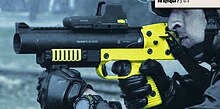Blast ball

Ablast ball,also known as atear gas ball,rubber ball grenade,sting ball grenade,orstinger grenade,is a ball-shaped, rubber coated,less-lethalgrenadedesigned forlaw enforcementandriot controlapplications. A blast ball is similar to astun grenadein that, when detonated, it generates a loud noise and bright light; however, it also releases a chemical irritant (usuallypepper gasortear gas) and occasionally also rubber pellets or fragments.
Blast balls are often used byriot policeto keep protestors back or separate "casual" rioters from "hardcore" instigators. They can also be used bypolice tactical unitsinclose-quarters combatto incapacitate suspects as a less-lethal and less-destructive alternative to actual grenades, which are generally unattainable by civilian law enforcement.
The use of blast balls in riot control is controversial. Proponents argue they are less harmful than traditional riot control agents or physical force,[1]while opponents argue they are used indiscriminately and are capable of harm.[2]
Application
[edit]
Blast balls can be used against aggressive crowds during situations in which rioters significantly outnumberpoliceorprison guards.In this application, they are intended to frighten away and disperse "casual" rioters, or those who have been "sucked into" the contagion of the crowd, allowing police or prison guards to separate them from, and engage with, the remaining "hardcore instigator" element.[3][4]
One typical deployment of blast balls occurred during the2011 Vancouver Stanley Cup riotand was described by aVancouver Police Departmentofficer:[5]
We started moving forward as a line but the crowd remained still. The gap narrowed to about 5 meters and some people started to move, but many would not move until they were physically contacted. This was very risky for us as we were significantly outnumbered and stretched very thin across six lanes of a major street. Once the order was given, the first blast ball landed about 2 meters in front of the crowd and got some people moving. As more dropped, the crowd turned and ran and we drove them to the end of the block. The police line held at the intersection, which allowed negotiators to use the public address system to warn the crowd and encourage them to leave. We had pushed the crowd past all the burning cars on the block and a large number of the "lesser influenced" crowd had dispersed. What remained were the hardcore instigators and a few hundred enthusiastic participants.
Blast balls can also be used to create "negative stimulus" by detonating in areas toward which police do not want the crowd to move, creating a herding effect.[3][4]
Manufacturers
[edit]Blast balls are marketed by AMTEC Less-Lethal Systems, Combined Tactical Systems, and Defense Technology, among other manufacturers.[6][7]Blast balls manufactured by AMTEC weigh 212 grams and contain either 14 grams of OC gas or 12 grams of CS gas.[7][8]
Safety
[edit]The use of blast balls as a riot control measure is controversial. Opponents argue that blast balls are used indiscriminately against peaceful protestors and that they are capable of causing physical harm.[1][2]Proponents and police argue blast balls, when used properly, are less harmful than traditional riot control measures such as pepper spray, tear gas, orbatonstrikes, which would have to be resorted to without blast balls.[1]
In 2015, a Seattle woman sued theSeattle Police Department(SPD), alleging shrapnel from a blast ball penetrated her leg.[9]The SPD denied her claims, alleging that tests show that a blast ball detonated at contact range againstballistic gelfails to produce trauma or tearing.[3]In 2020, a judge found the SPD in contempt for frequent use of blast balls while attempting to quell theGeorge Floyd protests in Seattle,finding that they were used "when no immediate threat to the officers' safety or public property could be identified".[2]
See also
[edit]References
[edit]- ^abc"Seattle Police Say 'Blast Balls' Safer Than Other Methods of Crowd Control".KNKX Public Radio.2016-08-16.Retrieved2022-11-15.
- ^abc"Judge: Seattle police in contempt for blast balls at BLM rallies".Police1.Retrieved2022-11-15.
- ^abcMyers, Chris (3 December 2010)."Crowd control with OC blast-ball grenades".PoliceOne.Retrieved8 September2015.
- ^abCarter, Mike (2 May 2013)."How Seattle police seized control of volatile May Day night".The Seattle Times.Retrieved8 September2015.
- ^Burns, Thomas (2014).Risk Management of Less Lethal Options.CRC Press. p. 23.ISBN978-1466563032.
- ^"Tear Ball Grenades".combinedsystems.Combined Tactical Systems.Retrieved8 September2015.
- ^ab"OC Blast Ball Grenade"(PDF).lesslethal.AMTEC Less Lethal Systems. Archived fromthe original(PDF)on 4 March 2016.Retrieved8 September2015.
- ^"CS Blast Ball Grenade"(PDF).lesslethal.AMTEC Less Lethal Systems.Retrieved8 September2015.[permanent dead link]
- ^Burton, Lynsi (21 July 2015)."Lawsuit: SPD recklessly targeted, injured volunteer medics at May Day protest".Seattle Post-Intelligencer.Retrieved8 September2015.
